
Karenia brevis is a microscopic, single-celled, photosynthetic organism in the genus Karenia. It is a marine dinoflagellate commonly found in the waters of the Gulf of Mexico. It is the organism responsible for the "Florida red tides" that affect the Gulf coasts of Florida and Texas in the U.S., and nearby coasts of Mexico. K. brevis has been known to travel great lengths around the Florida peninsula and as far north as the Carolinas.

Brevetoxin (PbTx), or brevetoxins, are a suite of cyclic polyether compounds produced naturally by a species of dinoflagellate known as Karenia brevis. Brevetoxins are neurotoxins that bind to voltage-gated sodium channels in nerve cells, leading to disruption of normal neurological processes and causing the illness clinically described as neurotoxic shellfish poisoning (NSP).

Cerithiidae, common name the cerithiids or ceriths, is a large family of medium-sized marine gastropods in the clade Sorbeoconcha.

Miodentosaurus is a genus of thalattosaurian from the Late Triassic of China. It is one of several thalattosaurs found in the Xiaowa Formation, also known as the Wayao Member of the Falang Formation. The genus name "Miodentosaurus" translates to "Few toothed-lizard" while the species name "brevis" means "short", in reference to its short snout.

Karenia is a genus that consists of unicellular, photosynthetic, planktonic organisms found in marine environments. The genus currently consists of 12 described species. They are best known for their dense toxic algal blooms and red tides that cause considerable ecological and economical damage; some Karenia species cause severe animal mortality. One species, Karenia brevis, is known to cause respiratory distress and neurotoxic shellfish poisoning (NSP) in humans.

Cerithium caeruleum, the Cerith sand snail, is a species of sea snail, a marine gastropod mollusk in the family Cerithiidae. It is generally found in large populations on intertidal rocky shores with a thin layer of sediments. They have large and solid shells, and their radula ribbon robust long about one-fifth the shell length. This species lives in the planktonic stage from 90 to 120 days and has a seven-year life history. This common intertidal species is confined to east Africa, Madagascar, and the Arabian Peninsula and is unlikely to be confused with any other Cerithium species. It is distinguished by its squat, knobby shape; and as indicated by its name, caeruleum, a grayish blue color with spiral rows of black tubercles.
Clypeomorus admirabilis is a species of sea snail, a marine gastropod mollusk in the family Cerithiidae.
Clypeomorus adunca is a species of sea snail, a marine gastropod mollusk in the family Cerithiidae.

Clypeomorus batillariaeformis, common name : the necklace or channeled cerith, is a species of sea snail, a marine gastropod mollusk in the family Cerithiidae.
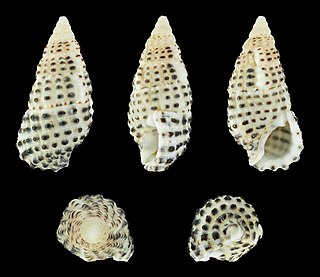
Clypeomorus bifasciata is a species of sea snail, a marine gastropod mollusk in the family Cerithiidae.
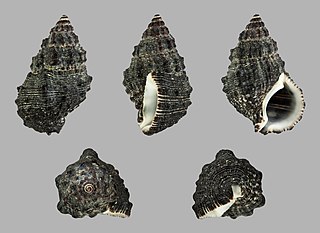
Clypeomorus inflata is a species of sea snail, a marine gastropod mollusk in the family Cerithiidae.
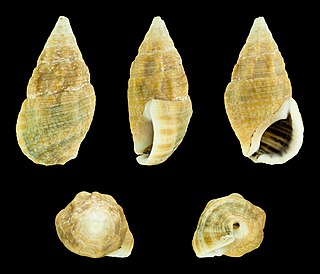
Clypeomorus irrorata is a species of sea snail, a marine gastropod mollusk in the family Cerithiidae.
Clypeomorus nympha is a species of sea snail, a marine gastropod mollusk in the family Cerithiidae.
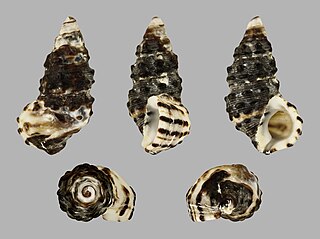
Clypeomorus pellucida, common name the pellucid clitus , is a species of sea snail, a marine gastropod mollusk in the family Cerithiidae.

Clypeomorus bifasciata persica is a subspecies of sea snail, a marine gastropod mollusk in the family Cerithiidae.
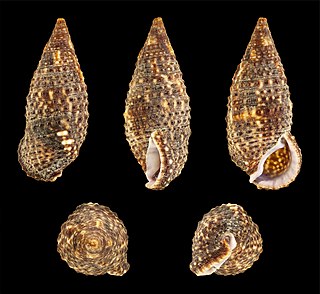
Clypeomorus purpurastoma is a species of sea snail, a marine gastropod mollusk in the family Cerithiidae.

Clypeomorus subbrevicula is a species of sea snail, a marine gastropod mollusk in the family Cerithiidae.
Clypeomorus verbeekii is a species of sea snail, a marine gastropod mollusk in the family Cerithiidae.

Clypeomorus is a genus of sea snails, marine gastropod mollusks in the subfamily Cerithiinae of the family Cerithiidae.

Prionovolva is a genus of sea snails, marine gastropod mollusks in the family Ovulidae.















